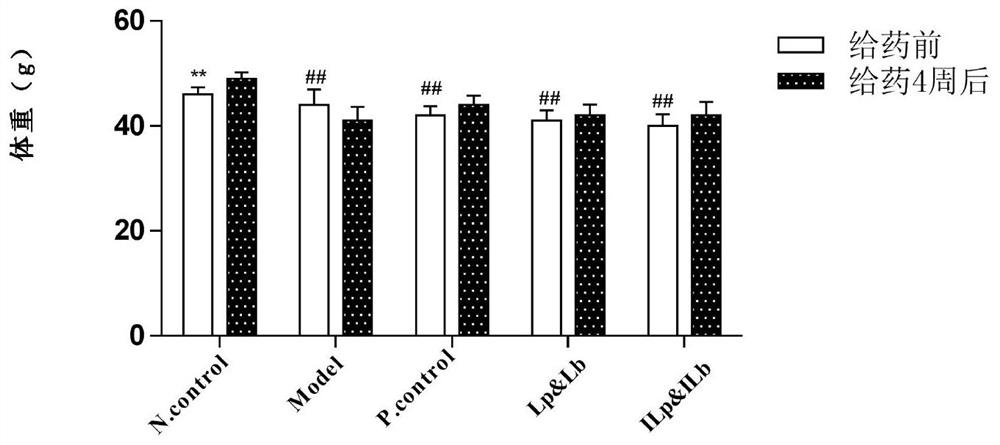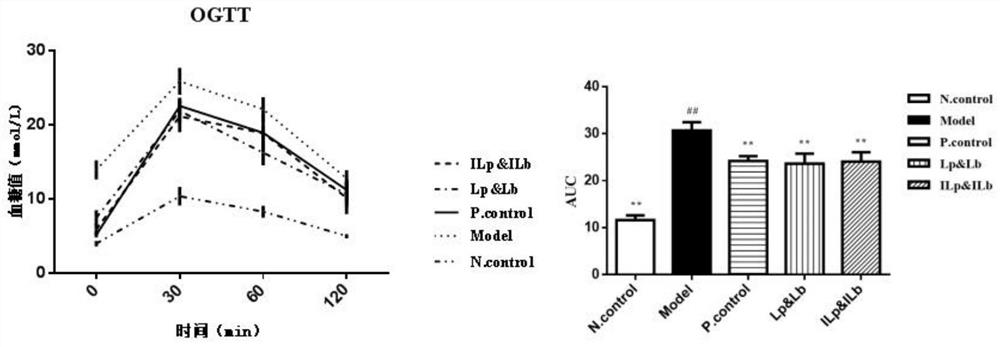Application of inactivated lactic acid bacteria compound in preparation of product for treating and/or preventing diabetes
A technology of lactic acid bacteria and compound, applied in the field of hypoglycemic, can solve the problems of complex production process of live bacteria preparation, inferior hypoglycemic effect and high cost
- Summary
- Abstract
- Description
- Claims
- Application Information
AI Technical Summary
Problems solved by technology
Method used
Image
Examples
Embodiment 1
[0034] Preparation of Inactivated Lactic Acid Bacteria Complex
[0035] MRS solid medium (both MRS broth medium and agar were purchased from Beijing Aoboxing Biotechnology Co., Ltd.) was sterilized at 121°C for 25 minutes, placed on a slant to cool to room temperature, lined aseptically in an ultra-clean workbench, and then Add Lactobacillus plantarum CICC 24202 (Lp) and Lactobacillus breve YM 1301Lp (Lb) cultured in glycerol, and culture in an incubator at 37°C for 24-48 hours, and repeat the activation 2-3 times. Sterilize the MRS liquid culture medium (250mL Erlenmeyer flask liquid volume is 50mL) in the Erlenmeyer flask at 115°C for 20min, cool to 30-40°C, pick the well-growth colonies on the slant culture medium, and inoculate Cultured in MRS liquid medium.
[0036] After culturing the liquid medium for 18 hours, mix Lp and Lb according to the volume ratio of 1:1, count them, and adjust to 10 with sterile normal saline. 8 CFU / mL, which is the oral live bacterial preparati...
Embodiment 2
[0039] Animal experiment
[0040] 50 male Kunming mice, weighing 18g±2g, were raised in a clean animal room, kept at a constant temperature of 24±1°C, with a relative humidity of 50%-70%, simulated light for 12h day and night cycles, standard experimental feed and free drinking water, and adapted to Experiments were started one week after sexual feeding. The mice were randomly divided into two groups: the normal control group (N.control) and the model group. The normal control group (10) was given ordinary feed, and the model group (40) was given high-fat diet (High Fat Diet, HFD). feed. After feeding with high-fat feed for 4 weeks from the second week, in addition to the normal control group, the model group was given multiple small doses of streptozotocin (STZ, purchased from Sigma, USA, 70 mg / kg, intraperitoneal injection) to induce Type 2 diabetes mellitus (T2DM) mouse model occurs, (STZ is dissolved in 0.1mol / L citric acid-sodium citrate buffer solution, pH = 4.4, is pr...
Embodiment 3
[0044] The fasting blood glucose of the type 2 diabetes model mice was ≥11.0mmol / L, which was considered as successful modeling. Relevant studies have shown that feeding high-fat diets will cause obesity, hyperinsulinemia and insulin resistance in mice, rather than obvious hyperglycemia or diabetes, and the injection of STZ will directly lead to the destruction of pancreatic β cells, resulting in insulin deficiency rather than insulin resistance Therefore, insulin resistance can be induced by high-fat diet, and then injected with low doses of STZ to damage islet function and cause blood sugar to rise, which can simulate the pathogenesis of type 2 diabetes.
[0045] The mice after successful modeling in Example 2 were randomly divided into 4 groups, namely the model group, the positive drug group, the live bacteria group and the inactivated bacteria group, and the treatment methods were the same as in Example 2. The fasting blood glucose was measured as the initial blood glucos...
PUM
 Login to View More
Login to View More Abstract
Description
Claims
Application Information
 Login to View More
Login to View More - R&D
- Intellectual Property
- Life Sciences
- Materials
- Tech Scout
- Unparalleled Data Quality
- Higher Quality Content
- 60% Fewer Hallucinations
Browse by: Latest US Patents, China's latest patents, Technical Efficacy Thesaurus, Application Domain, Technology Topic, Popular Technical Reports.
© 2025 PatSnap. All rights reserved.Legal|Privacy policy|Modern Slavery Act Transparency Statement|Sitemap|About US| Contact US: help@patsnap.com



